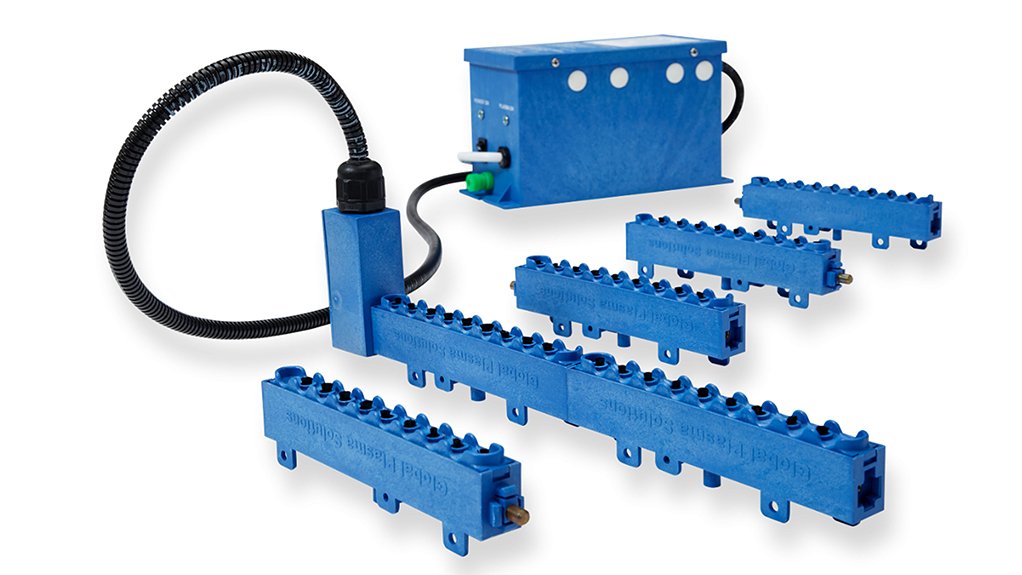New air purification technology helps combat Covid-19


A modular needlepoint bipolar ionisation system can purify indoor air where natural ventilation is not possible. Credit: Global Plasma Solutions.
The importance of circulating purified air in closed, crowded spaces is a crucial part of minimising the spread of droplet- or air-borne diseases such as Covid-19 and tuberculosis.
The World Health Organisation recently acknowledged the importance of fresh air in preventing the spread of Covid-19, saying: “Current evidence suggests that the virus spreads mainly between people who are in close contact with each other, typically within one metre (short-range) … The virus can also spread in poorly ventilated and, or crowded indoor settings, where people tend to spend longer periods of time. This is because aerosols remain suspended in the air or travel farther than one metre (long-range).”
While ventilation with outdoor air is key in preventing airborne diseases, there are settings in which adequate ventilation with fresh air is not possible, such as a shop in the middle of a shopping mall, or a doctor’s waiting room in a closed-off part of a building. Although some of these spaces may be equipped with air conditioning units, these typically only cool or heat air and do not filter air.
Needlepoint Bipolar Ionisation technology offers a solution to effectively filter and purify air and remove pathogens and pollutants that may be harmful to humans or the environment.
“Various technologies exist to clean air of pathogens, toxic fumes, mould, allergens and smells. Technologies such as UVGI, HEPA and carbon filters and bipolar ionisation have existed for a long time, but not all these technologies are effective when it comes to cleaning pathogens such as the Corona virus from the air,” says SPP Air Purification CEO Hercules Sandenbergh.
“Most of these technologies are installed overhead against walls or in the ceiling of a building, while we need to clean the air in between people. Some of these technologies are harmful to people and the environment, which makes their use questionable.
“Previously, bipolar ionisation technologies have come under fire as their processes create harmful biproducts, such as Ozone (O3), which when inhaled can damage the lungs, cause chest pain and shortness of breath. However, SPP Needlepoint Bipolar Ionisation creates no harmful biproducts. It works by introducing air ions into a closed public space.”
The ions are charged particles which attach to other particles, such as viral pathogens, toxic or noxious gases and moulds, and inactivate the particles by destroying them or causing them to become too heavy to remain suspended in the air.
The company emphasises that limited testing on the effectiveness of Needlepoint Bipolar Ionisation has shown that with an exposure time of 60 minutes, it has a kill rate of 90% against the coronavirus. It has also been shown to be effective against other pathogens such as:
- Tuberculosis – 69% kill rate over an exposure time of 60 minutes
- Norovirus – 93% kill rate over an exposure time of 30 minutes
- mould spores – 99.5% kill rate over an exposure time of 24 hours
- E-coli – 99.7% kill rate over an exposure time of 15 minutes, and
- legionella – 99.7% kill rate over an exposure time of 30 minutes.
Since its introduction, Needlepoint Bipolar Ionisation has been deployed by multiple US firms in over 150 000 installations worldwide, including at institutions such as Google, Duke University Medical, the Tampa Bay Lightning Arena, the White House, Mayo Clinic and the Boston Children’s Hospital. It has also been tested by the US military and used by the US Air Force to decontaminate aircraft.
Needlepoint Bipolar Ionisation is introduced through a standard heating, ventilation, and air conditioning system, which can be retrofitted. It is said to be more cost-effective than a high-efficiency particulate air, or HEPA, filtration system and is suitable for small businesses, such as doctors’ waiting rooms, as well as for medium-sized and large offices with high occupancy rates, such as call centres and banks.
Comments
Press Office
Announcements
What's On
Subscribe to improve your user experience...
Option 1 (equivalent of R125 a month):
Receive a weekly copy of Creamer Media's Engineering News & Mining Weekly magazine
(print copy for those in South Africa and e-magazine for those outside of South Africa)
Receive daily email newsletters
Access to full search results
Access archive of magazine back copies
Access to Projects in Progress
Access to ONE Research Report of your choice in PDF format
Option 2 (equivalent of R375 a month):
All benefits from Option 1
PLUS
Access to Creamer Media's Research Channel Africa for ALL Research Reports, in PDF format, on various industrial and mining sectors
including Electricity; Water; Energy Transition; Hydrogen; Roads, Rail and Ports; Coal; Gold; Platinum; Battery Metals; etc.
Already a subscriber?
Forgotten your password?
Receive weekly copy of Creamer Media's Engineering News & Mining Weekly magazine (print copy for those in South Africa and e-magazine for those outside of South Africa)
➕
Recieve daily email newsletters
➕
Access to full search results
➕
Access archive of magazine back copies
➕
Access to Projects in Progress
➕
Access to ONE Research Report of your choice in PDF format
RESEARCH CHANNEL AFRICA
R4500 (equivalent of R375 a month)
SUBSCRIBEAll benefits from Option 1
➕
Access to Creamer Media's Research Channel Africa for ALL Research Reports on various industrial and mining sectors, in PDF format, including on:
Electricity
➕
Water
➕
Energy Transition
➕
Hydrogen
➕
Roads, Rail and Ports
➕
Coal
➕
Gold
➕
Platinum
➕
Battery Metals
➕
etc.
Receive all benefits from Option 1 or Option 2 delivered to numerous people at your company
➕
Multiple User names and Passwords for simultaneous log-ins
➕
Intranet integration access to all in your organisation



















